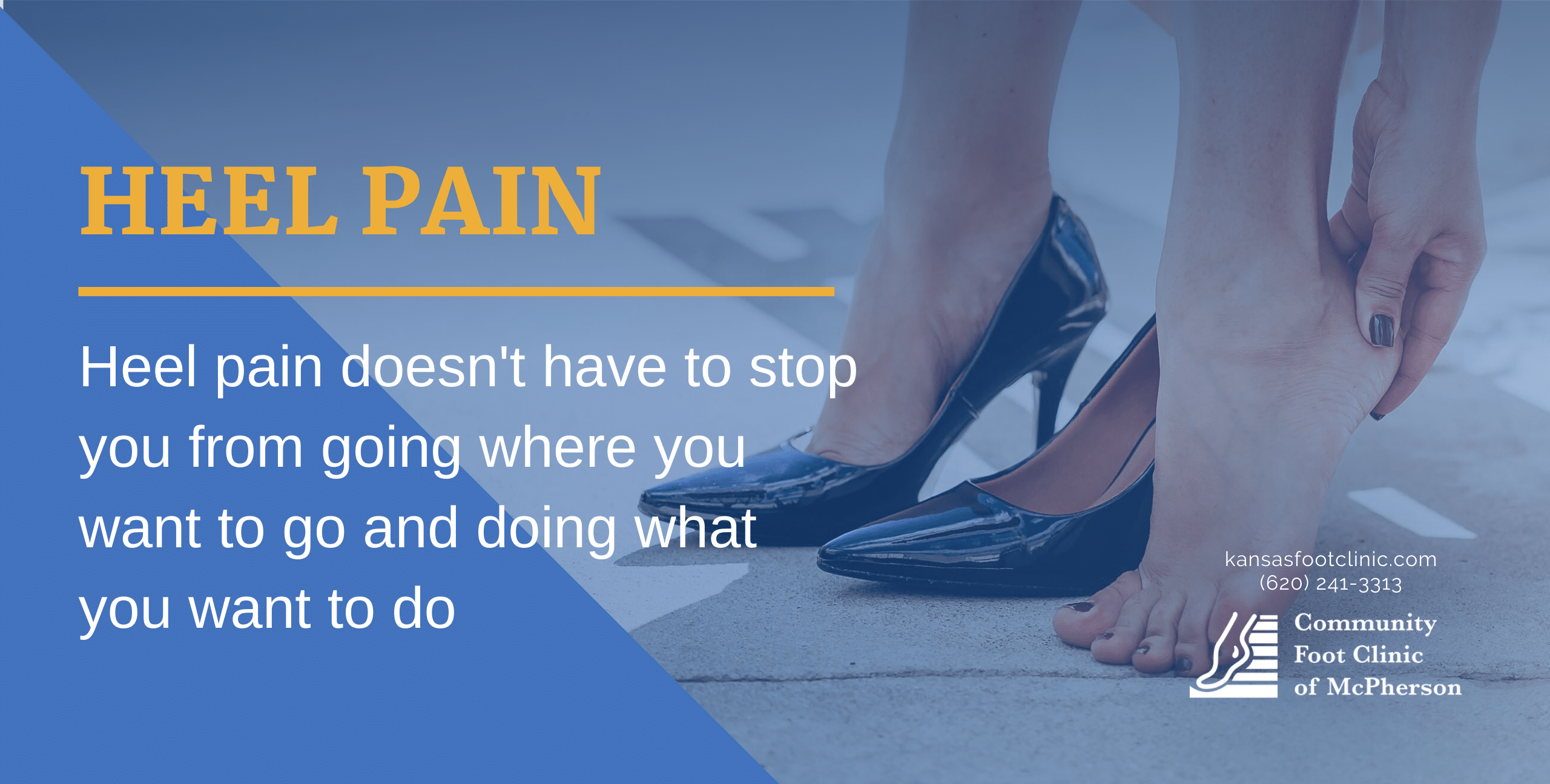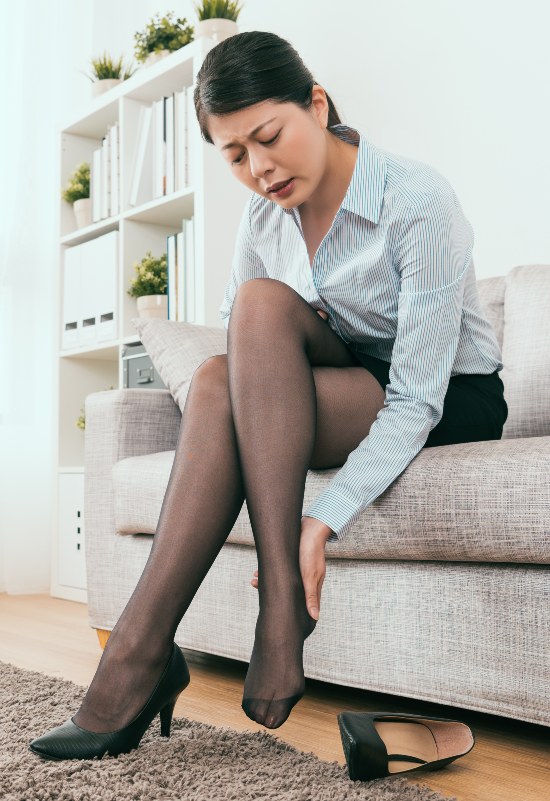Heel Pain
The average person takes about 8,000 steps per day—a distance of roughly four miles. In two years, you’ll probably have walked far enough to make it from McPherson to New York City—and back! After a lifetime on your feet, you’ll have logged enough miles to circle the earth four, maybe five times.
So, it shouldn’t be much of a surprise that heel pain is both very common and quite a detriment to quality of life. Heel pain may manifest as a sharp, stabbing sensation when you get out of bed in the morning, as burning or tingling, or as an ache that progressively gets worse over the course of the day.
Fortunately, it is very treatable. If heel pain is limiting your activity or causing you discomfort, give us a call.

Common Heel Pain Causes
The most frequent underlying cause of heel pain is overuse or overexertion. In other words, when you place too much force and pressure on the heels over too short a period of time, without giving your heels adequate time to rest or recover, chronic pain can set in.
There are many factors that could lead to this state of affairs—far too many to list on a single page. However, these are some of the most common:
- Wearing shoes that don’t provide adequate support or cushioning for your activity—like flip flops, for example, instead of comfortable walking shoes.
- Working a job that requires a lot of standing and walking.
- Playing sports or having active hobbies that require a lot of running and jumping, particularly on hard surfaces or difficult terrain.
- Dramatically increasing your activity level or changing your exercise routine without gradually conditioning your body to handle the strain first.
- Foot shapes or biomechanical flaws that leave you more prone to developing heel pain. This might include flat or high arches, overpronation, landing too hard on your heels when you run, etc.
- Being overweight.
Common Heel Pain Diagnoses
While overuse tends to be the underlying cause in most cases, there are also a variety of different clinical diagnoses that can be responsible for the symptoms. It all depends on what specific part of the body has been injured, and how severe it is.
- Plantar fasciitis is the most common cause of heel pain along the underside of the heel, and is the result of a damaged plantar fascia ligament. The plantar fascia tightens up at night, so the first steps of the morning often cause sharp pain.
- Achilles tendinitis affects the back of the heel, specifically the “heel cord” behind the ankle. It is caused by swelling and inflammation in the tendon that connects the heel bone to the calf muscle.
- Bursitis symptoms are very similar to those of Achilles tendinitis. However, the cause of this condition is inflamed bursae, which are fluid-filled pads that cushion muscles and tendons near the heel.
- Heel spurs are bony projections that form at the front of the heel bone and point toward the arch. They may form in response to chronic plantar fasciitis, and are not always painful on their own. They can be detected via X-ray.
- Compressed nerves, also known as pinched nerves, can lead to tingling or burning pain in the heels and feet. Nerves that run through narrow tubes and tunnels in the ankle are especially vulnerable to physical pinching or obstruction.
Treating Heel Pain
The specific techniques we may recommend to address your heel pain will depend on the condition and cause of the symptoms, how the pain is affecting your life, what treatments have already been attempted, and other factors. Personalizing treatment to the needs of each individual helps us achieve the best possible outcomes for our patients!
That said, a “general” game plan for addressing heel pain in a fairly typical scenario might look like this:
Home Care
Whenever you notice heel pain beginning to develop, you may wish to attempt home treatment first. Taking care of yourself as soon as possible can help prevent heel pain from progressing to a more serious stage.
- Slow down, avoid strenuous physical activities that cause pain. Prop your feet up or rest them on a pillow when you sit or sleep.
- If you notice swelling, try applying ice for about 15 minutes, 2-3 times per day.
- Avoid shoes that are too tight (or too loose), don’t support your feet, don’t cushion your heel, or just aren’t appropriate for your chosen activity.
Further Care Options
If heel pain is severe, or keeps returning despite home care, you may need further care from our team. We always start with conservative treatments, which may include options such as:
- Stretching
- Wrapping
- Anti-inflammatory medications
- Physical therapy
- Cortisone injections
- Laser therapy—this is an advanced, painless, and virtually risk-free treatment that helps stimulate your body’s naturally healing processes to trigger rapid improvement in most patients. It’s especially loved by athletes and those who work on their feet.
In many cases, once the painful symptoms have been reduced or eliminated, we will prescribe custom orthotics to correct any underlying biomechanical issues causing heel pain in the first place. These devices are custom-molded to the exact shape of your feet and slide right into your shoes. They place your feet in a more natural position and improve ergonomics and alignment throughout your entire skeleton—not just your feet.
Most of our patients respond positively to conservative treatments; surgery is only rarely necessary. The longer you wait to receive treatment, however, the more likely your condition will become chronic and require more aggressive intervention.
At Community Foot Clinic of McPherson, we understand the difficulty of heel pain. Call 620-241-3313 or request an appointment online today!
McPherson Office
316 W. 4th Street
McPherson, KS 67460
P: (620) 241-3313
F: (620) 241-6967
© Community Foot Clinic of McPherson. All Rights Reserved.
Privacy Policy | Terms & Conditions
Web Design by CP Solutions
Marketed by VMD Services

